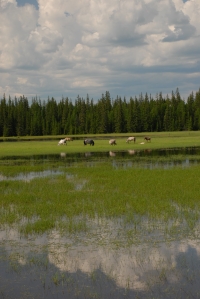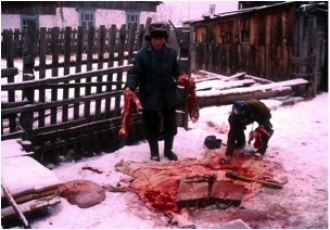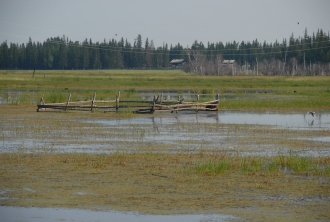By: Susan A. Crate, George Mason University
Mobility is central to the livelihoods of the diverse reindeer-herding, hunting/gathering, and pastoralist peoples inhabiting the circumpolar north. Like their circumpolar neighbors, today the livelihoods of Russia's indigenous peoples are challenged by the local effects of climate change and by other changes including industrial contamination, economic transformations, globalization and modernity, and alienation of their youth. In contrast, Russia's northern inhabitants bear the brunt of a unique historical legacy of 17th century colonization, Sovietization, and de-Sovietization, which works to hamper mobility, distance resources, and impede land rights. Based on NSF-funded longitudinal research in northern Russian communities since 1991, anthropologist Susan Crate of George Mason University analyzed issues of climate change and mobility for a Brookings Institution Report. The report is based on Crate's findings in a case study of Viliui Sakha and supplemented with examples of relocation and mobility on a regional and national scale and discussions on indigenous and governmental response. The report shows how anthropological investigation provides a window into the complexity of local livelihoods and, among other things, how that perspective offers a crucial contribution to the policy debate on climate change. The following article highlights findings of that report.
Mobility is central to the livelihoods of many of the peoples inhabiting northern Eurasia. That mobility was hampered first by 17th century Russian colonization and most dramatically by 20th century Sovietization. Collectivization policies forced settlement and consolidation to account for production and to provide schooling. Resettlement divided families and separated inhabitants from their birth lands. The government relocated technical "specialists" from western Russia to the state farms, further altering the demographics of communities. After the 1991 fall of the Soviet Union, most state farm and collective activities ceased. Inhabitants today depend to a greater or lesser extent on pre-Soviet subsistence. In addition to these historical constraints affecting mobility, climate change is also beginning to affect northern Russia's indigenous livelihoods.

The effects of global warming in the Russian North include permafrost degradation; increasing ambient air temperatures, precipitation, and frequency of extreme events; and an overall "softening" of the climate, characterized by the lessening of the extreme cold of winters and sweltering heat of summers. These effects trigger altered seasonal timings (phenology) and ranges of animals and plants (Roshydromet 2008). In-country scientists report within the Sakha area an unprecedented increase in permafrost degradation, average annual precipitation rates, and air temperature in the last decade, all attributed to climate change (Fedorov and Konstantinov, 2009).
The case study of one northern group, Viliui Sakha, provides a close-up understanding of mobility, resettlement, and relocation in the face of contemporary climate change. Viliui Sakha are horse and cattle breeders, a livelihood brought from the south by their Turkic ancestors. In the Soviet period, they were gradually consolidated into larger and larger collective operations, which culminated in extensive agro-industrial state farms. Viliui Sakha adapted to the fall of the Soviet Union by developing household-level food production based on keeping cows and strengthening dependence on kin households, a strategy termed "cows and kin" (Crate 2006).

Soviet policies and the post-Soviet aftermath to date have had a much greater impact on Viliui Sakha livelihoods than climate change. However, regional scientific data and local observations show that the climate change trends, including permafrost degradation and increasing precipitation, will require Viliui Sakha to relocate if they intend to maintain their cow and horse breeding practices. Based on findings from Crate's NSF projects1, inhabitants identify nine main changes (Crate 2011) and are most concerned about and affected by the increasing water on the land (see Figure 1 and Figure 3 ) and the changes in seasonal timing (see Figure 2).
Other cases further illustrate issues of mobility and relocation within the Sakha Republic. In the Republic 92 villages (15%), which are home to 136,000 inhabitants (7% of the total population), are in the direct path of flood incidents. In 1998 and 2001 the Republic had catastrophic floods. In 2002 the Sakha government passed a resolution to "relocate the most affected flooded villages," beginning in Kyllakh with plans to move the village from its original location on an island in the Lena River to a non-flooding terrace on the right bank. Residents remain on the island despite the state's efforts to relocate the community and despite continued and increasing flooding. Reasons they remain include the huge expense to move for individual households, the lack of pasture and fodder in the new location, and the difficulty of psycho-social adaptation to a new place.
The government is also responding through the Republic's Rescue Service, as specialists have developed an early warning system to evacuate areas that have an impending catastrophe. Rescue service experts claim that with this system in place, not a single person has died in floods since 2007.
Other indigenous peoples within the Sakha republic (e.g., Even, Evenk, Yukagir, Chukchi) are migrating for many reasons, including climate change. In contrast to Sakha, the herding,hunting, fishing, gathering populations have both advantages and limitations. Because their subsistence mode is based primarily on mobility, they have greater flexibility to move in the face of calamity to maintain subsistence. Conversely, the changes in climate and seasonal patterns negatively affect the wild resources essential to their livelihoods.
The lessons from these three examples are:
If a community such as Kyllakh must relocate, sufficient research—ideally in collaborative consultation with the affected communities—must inform an appropriate resettlement site where inhabitants can continue their livelihood practices.
Early warning systems are needed to enable evacuation of settlements in a timely fashion.
Livelihood type is a critical consideration in understanding a peoples' need to move or stay and their capacity to adapt to change.
Comparisons and Contrasts Across Northern Russia
This section of the report illustrates, through three mini-cases—the Nenets of Yamal, the Dolgan and Nganasan of Taimyr, and the Chukchi and Siberian Yupik of Chukotka—the diverse ways in which climate change affects mobility. In contrast to indigenous peoples of the rest of the circumpolar north, these groups all face the impact of climate change within the context of a common Soviet and post-Soviet legacy that limits their mobility options and adaptation to climate change. The full Brookings report examines both the commonalities and the diversity among northern Russia's indigenous peoples facing intersecting change factors, with an emphasis placed on how perceptions shape peoples' understandings and responses.
The cases in Russia illustrate the interaction of various factors of change, including oil and gas development of Yamal affecting Nenets' livelihoods; the restraints on hunters' mobility and access to wild resources of the Dolgan and Nganasan; and the relocation from optimal sea-mammal hunting camps and pastoral access of the Chukchi and Siberian Yupik. These cases also highlight the effects of climate in that mix and how perceptions are based in local understandings of the world.
The Indigenous Response
One major development for Russia's indigenous peoples has been the establishment of the Russian Association of Indigenous Peoples of the North, Siberia, and the Far East (RAIPON). But while RAIPON has made progress, the key to on-the-ground change for Russia's affected peoples is policy development and implementation, which is challenging (see full text of report for details). Other successes in indigenous response include collaboration between local communities and researchers. Additionally, to facilitate indigenous response, a great deal needs to be done in raising awareness among local communities about the impact of climate change. For example, research with Viliui Sakha found that while inhabitants observed changes in their environment and understood its effects on their livelihoods, they attributed most of the changes to sources other than climate change (Crate 2011).
Communities need first to be able to understand how climate change is affecting present and future livelihoods and how climate change interacts with the other change factors in their lives. To address this need, Crate explored with the Viliui Sakha communities a process of community-collaborative knowledge exchange, which aimed to establish dialogue between regional scientific data and local knowledge based in lifelong observations (Crate, in press). Such climate change literacy empowers local inhabitants and scientists alike. Inhabitants can be more proactive in engaging with local, regional, and federal representatives concerning the impacts on their livelihoods, including the likelihood that they will have to relocate. Regional scientists gain an intimate understanding of how a global phenomenon, in this case climate change, has a diversity of effects on ecosystems and human adaptation to a changing environment.
The Government Response
It would be too extreme to say that Russia's federal government is in climate denial, considering how far official policies have come in establishing climate change as a federal policy problem2. While there are still murmurs in federal boardrooms of "scientific uncertainties" and still many skeptical voices in Russia's media, the policy discourse has shifted from discussing causes of climate change to debating its economic and political costs and benefits. However, Russian governmental bodies at the regional level have been more responsive.
Here the international circumpolar community can help. At both the federal and regional governmental levels there is a great need for sharing experiences with other circumpolar countries, particularly in the areas of:
How to govern and redesign policy that accommodates indigenous livelihoods in the face of climate change, including implications for relocations and resettlements.
How to develop and sustain interdisciplinary research collaborations that bring together in-country and international natural and social science scholars for community-based projects to address issues of climate change and displacement.
How to further promote collective action/advocacy by arctic indigenous peoples.
How to create an enabling environment to promote understanding and thereby a greater capacity for action on the local level inclusive of research and policy communities.
Citations
1 NSF National Science Foundation, Office of Polar Programs, Arctic Social Science Program Grant 0710935 ''Assessing Knowledge, Resilience & Adaptation, and Policy Needs in Northern Russian Villages Experiencing Unprecedented Climate Change,'' and NSF National Science Foundation, Office of Polar Programs, Arctic Science Program Grant 0902146 "Understanding Climate-Driven Phenological Change: Observations, Adaptations, and Cultural Implications in Northeastern Siberia and Labrador/Nunatsiavut (PHENARC)."
2 For example, see the 2009 Climate Doctrine.
References
Crate, Susan A., in press. A Methodological Model for Exchanging Local and Scientific Climate Change Knowledge in Northeastern Siberia. Arctic. Forthcoming, Fall 2013.
Crate, Susan A. 2011. A Political Ecology of Water in Mind: Attributing Perceptions in the Era of Global Climate Change. Weather, Climate and Society. 3(3):148-164.
Crate, Susan A. 2006. Cows, kin and globalization: An ethnography of sustainability. Walnut Creek: Alta Mira Press.
Fedorov, A., and Konstantinov, P. 2009. Response of permafrost landscapes of central Yakutia to current changes in climate and anthropogenic impacts. Geography and Natural Resources 30(2):146-150.
Roshydromet. 2008. Assessment report on climate change and its consequences in the Russian Federation. Moscow: ROSHYDROMET.
Acknowledgements
Thanks to all my collaborators in the Sakha Republic, the Brookings Institution, the National Science Foundation, and all colleagues who contributed (for a full detailed list of acknowledgements, please see Brookings full report).
For further information, contact Susan A. Crate (scrate1 [at] gmu.edu).

